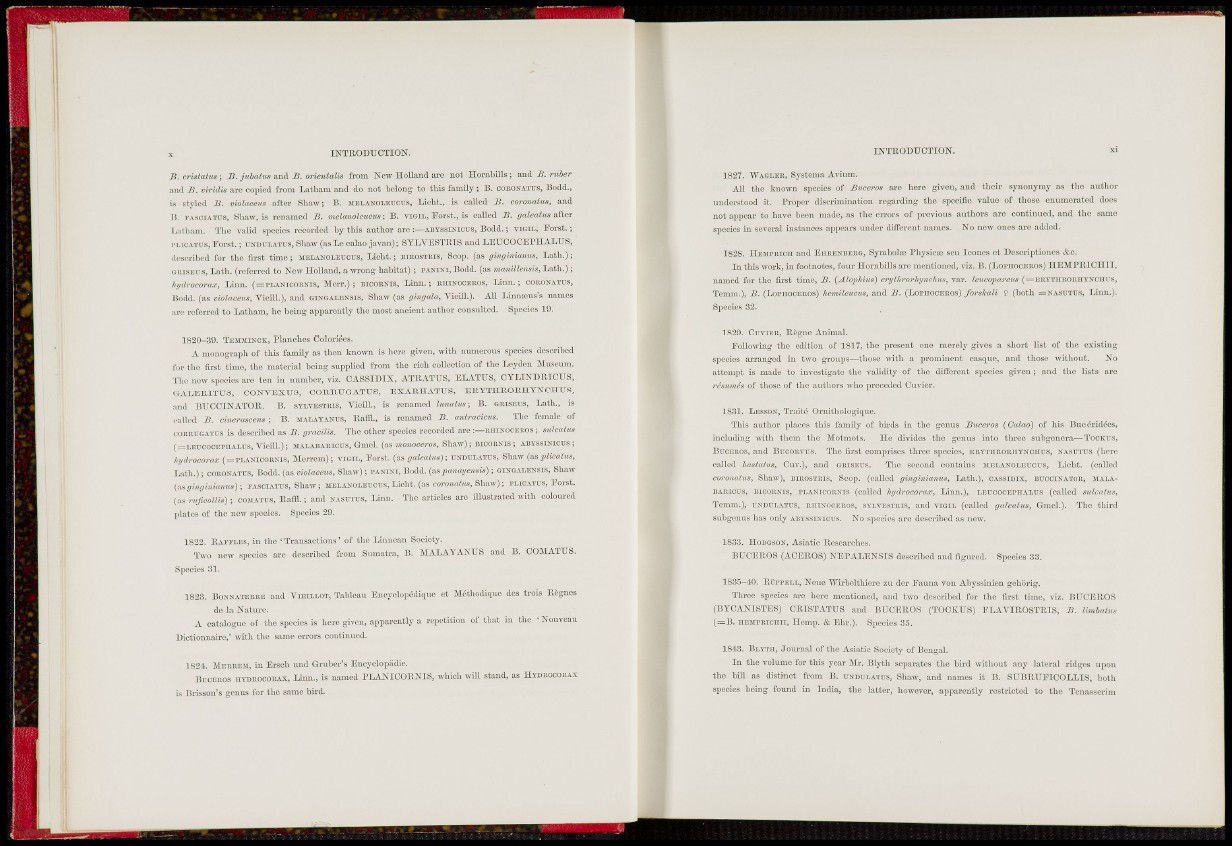
X INTRODUCTION.
B. cristatus-, B. jubatus B. orientalis from New Holland are not Uornbills; and B. ruber
and B. viridis are copied from Latliam and do not belong to tliis family ; B. CORONATTJS, Bodd.,
is styled B. violaceus after Shaw; B. MELANOLETJCUS, Licbt., is called B. coronaius, and
H. FASOIA-TL'S, Shaw, is renamed B. melanoleucus ; B. VIGIL, Porst., is called B. galeatus after
Latham. The valid spccies recorded by this author are :—.UÎTSSINICUS, Bodd. ; VIGIL, Torst. ;
I'LICATUS, Eorst. ; TJNDULATUS, Sliaw (as Le calao javan); SYLVESTRIS and LEUCOCEPIIALUS,
<lcscribed for the first time ; MELAKOLETJCUS, Licht. ; BIKOSTEIS, Scop, (as ginginiamis, Lath.) ;
GIIISEUS, Lath, (referred to New Holland, a wrong habitat) ; PANINI, Bodd. (as manillensis, Latb.) ;
hydrocorax, Linn. (=I'LANICOBNIS, Merr.) ; BICOENIS, Linn. ; ENINOCEBOS, Linn. ; COROKATUS,
Bodd. (as violaceua, Vieill.), and GINGALENSIS, Shaw (as gingala, VicilL). All Linnteus's names
are referred to Latham, he being apparently the most ancient author consulted. Species 19.
1820-30. TEMMINCK, Planches Coloriées.
A monograph of this family as then known is hero given, with numerous spccies described
lor the first time, the material being supplied from the rich collection of the Leyden Museum.
The new specics are ten in number, viz. CASSIDIX, ATRATUS, BLATITS, CYLIKDRICUS,
(iALERITUS, CONVEXUS, CORRUGATUS, ESARHATUS, ERTTHRORHYN CUTIS,
and BUCCINATOR. B. SÏLVESTEIS, Vieill., is renamed hinatiis-, B. GRISEI'S, Lath., is
called B. cinerasoens ; B. MALATA>'rs, Rail., is renamed B. antracicm. The female of
CORRUGATUS is dcscribcd as B. gracilis. The other specics recorded arc :—RNIKOCEIIOS ; s^tlcatus
( = LEUCOCEPUALTJS, Viei l l ) ; 5IALABARICUS, Gmcl. (as monoceros, Shaw); BICORNIS ; ABYSSINICUS ;
hydrocorax (=PLANICORKIS, Merrem); VIGIL, Eorst. (as galeaiiis)-, TJNDL-LATUS, Shaw plicaius,
Latli.) ; COEONATUS, Bodd. (as violaceus, Shaw) ; PANINI, Bodd. {a.^ pancujcnsis) ; GINGALENSIS, Shaw
{Ai^ginginianus) ; FASCIATL'S, Shaw; MELAXOLEECTJS, Licht. (as coronatiis, Shaw); PLICATUS, Eorst.
(as rufiColUs) ; CGJIATUS, Raffl. ; and KASUTUS. Linn. The articles are illustrated with coloured
plates of the new specics. Spccies 29.
1822. RAPFLES, in the 'Transactions' of the Linnean Society.
Two new spccies are described from Sumatra, B. MALAYANUS and B. COMATUS.
Specics 31.
1823. BONNATEERE and VIEILLOT, Tableau Encyclopédique et Méthodique des trois Règnes
de la Nature.
A catalogue oi the species is here given, apparently a repetition of that in the 'Nouveau
Dictionnaire,' with the same errors continued.
1821. SIEEREII, in Ersch und Grubcr's Encyclopadie.
BUCEEOS IIYDEOCOEAX. Linn., is named PLANICORNIS, which will stand, as HRDEOCORAX
s Brisson's genus for the same bird.
INTRODUCTION. xi
1827. "WAGLEE, Systcma Avium.
All the known specics of Buceros are here given, and their synonymy as the author
understood it. Proper discrimination regarding the specific value of those enumerated does
not appear to have been made, as the errors of previous authors are continued, and the same
species in several instances appears under different names. No now ones are added.
1826. IIEJIPEICH and EIIRENBEEG, Symbolaî PhysiciB scu Icones et Descriptiones &c.
In this work, in footnotes, four Uornbill s arc mentioned, viz. B. (LOPICOCEROS) IIEMPRICUII,
named for the first time, B. {AlopMus) erythrorhgnchm, var. leucopareus (=EEYTnROEnyNCUrs,
Temm.), B. (LOPHOCEEOS) Jiemileucm, and B. (LOPHOCEEOS) forskali $ (both =KASUTUS. Linn.),
Species 32.
1829. CuviEE, Règne Animal.
Following the edition of 1817, the present one merely gives a short list of the existing
species arranged in two groups—those Avith a prominent casque, and those without. No
attempt is made to investigate the validity of the different species given ; and the lists are
résumés of those of tlie authors who preceded Cuvier.
1831. LESSON, Traité Ornithologique.
This author places this family of bii'ds in the genus Buceros {Calao) of his Bucéridées,
including with them the Motmots. He divides the genus into three subgenera—Tocicus,
BI'CEEOS, and BUCOEVTJS. The first comprises three species, ERYTIIEOEIIYNCHUS, NASTJTUS (here
called hastatiis, Cuv.), and GEISEUS. The second contains MELANOLEUOUS, Licht. (called
coronaius, Shaw), BIROSTRIS, Scop, (called ginginianus. Lath.), OAssiDix, BTJOOINATOE, MALABAEICUS,
BICORNIS, PLANICOENIS (called hydrocorax. Linn.), LEUOOCEPIIALUS (called sulcalus,
Temm.),-L-NDULATUS, EIIINOCEROS, SYLVESTRIS, and VIGIL (called gcdealus, Gmel.). The third
subgenus has only ABYSSINICUS. NO species are dcscribcd as new.
1833. HODGSON, Asiatic Researches.
BUCEROS (ACEROS) NEPALENSIS described and figured. Species 33.
1835-40. RUPPELL, Neue TVirbelthiere zu der Pauna von Abyssinien gehörig.
Three species arc here mentioned, and two described for the first time, viz. JUJCEROS
(BYCANISTES) CRISTATUS and BUCEROS (TOCKUS) ELAYIROSTRIS, B. Umhatm
( = B . nEMPRicnii, Hemp. & Ehr.). Species 35.
1843. BLYM, Journal of the Asiatic Society of Bengal.
I n the volume for this year Mr. Blytii separates the bird without any lateral ridges upon
the bill as distinct from B. UNDULATUS, Shaw, and names it B. SUBRUEICOLLIS, both
species being found in India, the latter, however, apparently restricted to the Tcnasserim